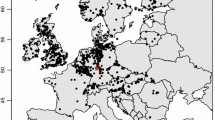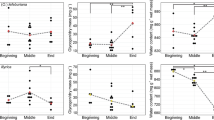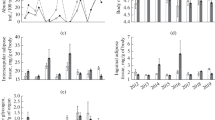Abstract
The concentration and seasonal dynamics of the major energy storage components, triglycerides and glycogen, were measured in two species of mayfly (Rhithrogena semicolorata and Ephemera danica) with contrasting life cycle strategies living in a small mountain stream. E. danica is a burrowing, semivoltine collector-gatherer; R. semicolorata is univoltine and scrapes periphyton from stones. This is the first publication which focuses on the role of metabolic energy sources during the larval life span of two mayfly species until the larvae emerge. Although triglycerides are the major energy reserve in both species (>84% of total energy storage) throughout the whole larval development their seasonal dynamic differed considerably. In R. semicolorata the triglyceride concentration declined during the last weeks prior to emergence in both sexes. The same pattern was found in female larvae of E. danica, but not in male E. danica. It is suggested that females use triglycerides in the last larval stages for egg maturation, which is completed in the last larval instar. In male E. danica the triglyceride concentrations remained high until emergence, presumably due to their high energy demands as adults for their swarming flights. Glycogen concentrations did not show such a difference between species and sexes. Its significance as a storage substrate for energy is rather low; however, concentrations decreased in both species and sexes prior to emergence.






Similar content being viewed by others
References
Beenakkers AMT (1969) Carbohydrate and fat as a fuel for insect flight. A comparative study. Insect Physiol 15:353–361
Beenakkers AMT, Van der Horst DJ, Van Marrewijk WJA (1985) Insect lipids and their role in physiological processes. Prog Lipid Res 24:19–67
Bergmeyer HU (1985) Methods of enzymatics analysis, vols VI, VII. Verlag Chemie, Weinheim
Cavaletto JF, Nalepa TF, Fanslow DL, Schloesser DW (2003) Temporal variation of energy reserves in mayfly nymphs (Hexagenia spp.) from Lake St Clair and western Lake Erie. Freshw Biol 48:1726–1738
Cavanoso LE, Jouni ZE, Karnas KJ, Pennington JE, Wells MA (2001) Fat metabolism in insects. Annu Rev Nutr 21:23–46
Doeg T, Lake PS (1981) A technique for assessing the composition and density of the macroinvertebrate fauna of large stones in streams. Hydrobiologia 80:3–6
Elliot JM, Humpesch UH, Macan TT (1988) Larvae of the British Ephemeroptera: a key with ecological notes. Scientific publications 49. Freshwater Biological Association, Ambleside
Flecker AS, Allan JD, McClintock NL (1988) Male body size and mating success in swarms of mayfly Epeorus longimanus. Holarct Ecol 11:280–285
Gewecke M (1995) Physiologie der Insekten. Fischer Verlag, Stuttgart
Grieshaber MK, Hardewig I, Kreutzer U, Pörtner HO (1994) Physiological and metabolic responses to hypoxia in invertebrates. Rev Physiol Biochem Pharmacol 125:44–147
Hara J, Radin NS (1978) Lipid extraction of tissues with a low-toxicity solvent. Anal Biochem 90:420–426
Harker JE (1992) Swarm behaviour and mate competition in mayflies (Ephemeroptera). Zool 228:571–587
Honèk A (1993) Intraspecific variation in body size and fecundity in insects: a general relationship. Oikos 66:483–492
Horton DR, Lewis TM, Neven LG (2005) Ovarian development and lipid reserves are affected by mating delays in three species of Anthocoris (Hemiptera: Anthocoridae). Can Entomol 137:328–336
Kosnicki E, Burian S (2003) Life history aspects of the mayfly Sipholunurus typicus (Ephemeroptera: Siphlonuridae) with a new application for measuring nymphal development and growth. Hydrobiologia 510:131–146
Kreutz FH (1962) Enzymatische Glycerinbestimmung. Klin Wochenschr 40:362
LeSage L, Harrison AD (1979) Improved traps and techniques for the study of emerging aquatic insects. Entomol News 90:65–78
Murata M, Tojo S (2002) Utilization of lipid for flight and reproduction in Spodoptera litura (Lepidoptera: Noctuidae). Eur J Entomol 99:221–224
Nation JL (2001) Insect physiology and biochemistry. CRC Press, New York
Peckarsky BL, Taylor BW, McIntosh AR, McPeek MA, Lyte DA (2001) Variation in mayfly size at metamorphosis as a developmental response to risk of predation. Ecology 82:740–757
Pinter JK, Hayashi JA, Watson JA (1967) Enzymatic assay of glycerol, dihydroxyacetone and glyceraldehyde. Arch Biochem Biophys 121:404
Sartori M, Keller L, Thomas AGB, Passera L (1992) Flight energetics in relation to sexual differences in the mating behaviour of a mayfly, Siphlonurus aestivalis. Oecologia 92:172–176
Scrimgeour GJ, Culp JM (1994) Feeding while evading predators by a lotic mayfly: linking short-term foraging behaviours to long-term fitness consequences. Oecologia 100:128–134
Warburg M, Yuval B (1996) Effects of diet activity on lipid levels of adult Mediterranean fruit flies. Physiol Entomol 21:151–158
Wesenberg-Lund C (1943) Biologie der Süßwasserinsekten. Springer, Berlin Heidelberg New York
Wieser W (1986) Bioenergetik. Energietransformation bei Organismen. Thieme Verlag, Stuttgart
Acknowledgments
We would like to thank Gabriele Egerer and Claudia Hellmann for their assistance in field and laboratory. We are also grateful for the very helpful comments of Christian Ortmann and three anonymous reviewers, which clearly improved our manuscript. Parts of this work were financially supported by the German research foundation (grant BE 1671/9-1). All our experiments comply with the current laws of Germany.
Author information
Authors and Affiliations
Corresponding author
Additional information
Communicated by G. Heldmaier
Rights and permissions
About this article
Cite this article
Winkelmann, C., Koop, J.H.E. The management of metabolic energy storage during the life cycle of mayflies: a comparative field investigation of the collector-gatherer Ephemera danica and the scraper Rhithrogena semicolorata . J Comp Physiol B 177, 119–128 (2007). https://doi.org/10.1007/s00360-006-0114-7
Received:
Revised:
Accepted:
Published:
Issue Date:
DOI: https://doi.org/10.1007/s00360-006-0114-7




